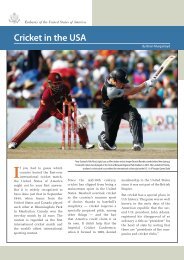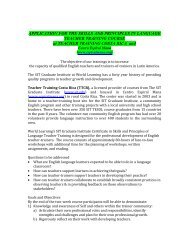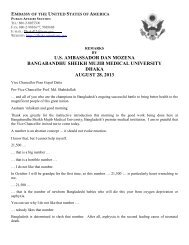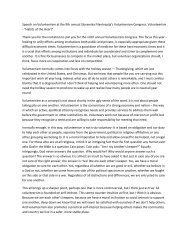Catalog Paris 2010 - Photo Gallery - US Department of State
Catalog Paris 2010 - Photo Gallery - US Department of State
Catalog Paris 2010 - Photo Gallery - US Department of State
Create successful ePaper yourself
Turn your PDF publications into a flip-book with our unique Google optimized e-Paper software.
Captured in Time<br />
ART in Embassies Exhibition <strong>Paris</strong>, France
Julius Shulman Case Study House #22, 1960 (printed later)<br />
Gelatin silver print, 20 x 16 in. (50,8 x 40,6 cm). Courtesy <strong>of</strong> Glenn and Michelle Robson, Los Angeles, California<br />
ART in Embassies ART dans les Ambassades<br />
Established in 1963, the U.S. <strong>Department</strong><br />
<strong>of</strong> <strong>State</strong>’s <strong>of</strong>fice <strong>of</strong> ART in Embassies (ART)<br />
plays a vital role in our nation’s public diplomacy<br />
through a culturally expansive mission,<br />
creating temporary and permanent exhibitions,<br />
artist programming, and publications. The Museum <strong>of</strong><br />
Modern Art first envisioned this global visual arts program<br />
a decade earlier. In the early 1960s, President<br />
John F. Kennedy formalized it, naming the program’s<br />
first director. Now with over 200 venues, ART curates<br />
temporary and permanent exhibitions for the representational<br />
spaces <strong>of</strong> all U.S. chanceries, consulates,<br />
and chief-<strong>of</strong>-mission residences worldwide, commissioning<br />
and selecting contemporary art from the U.S.<br />
and the host countries. These exhibitions provide<br />
international audiences with a sense <strong>of</strong> the quality,<br />
scope, and diversity <strong>of</strong> both countries’ art and culture,<br />
establishing ART’s presence in more countries<br />
than any other U.S. foundation or arts organization.<br />
ART’s exhibitions allow foreign citizens, many <strong>of</strong><br />
whom might never travel to the United <strong>State</strong>s, to<br />
personally experience the depth and breadth <strong>of</strong> our<br />
artistic heritage and values, making what has been<br />
called a: ‘’footprint that can be left where people have<br />
no opportunity to see American art.’’<br />
“The ART in Embassies program reveals the rich history<br />
and cultural heritage <strong>of</strong> the United <strong>State</strong>s and the<br />
communal experiences that we share with peoples <strong>of</strong><br />
different countries, backgrounds and faiths, binding<br />
us closer together. Through its temporary exhibitions<br />
and permanent collections, the ART in Embassies<br />
program intrigues, educates, and connects – playing<br />
an ambassadorial role as important as that served by<br />
traditional diplomacy.”<br />
— Hillary Rodham Clinton, Secretary <strong>of</strong> <strong>State</strong><br />
1<br />
Fondé en 1963, ART dans les Ambassades (ART) du<br />
Département d’État joue un rôle culturel essentiel dans<br />
la diplomatie publique de notre pays, incluant la création<br />
d’expositions temporaires et permanentes, la présentation<br />
d’artistes et de publications. Le Musée d’Art<br />
Moderne fut le premier à envisager ce programme<br />
d’arts visuels à l’échelle mondiale dix ans auparavant.<br />
Au début des années 1960, le président John F.<br />
Kennedy l’<strong>of</strong>ficialisa en nommant le premier directeur<br />
du programme. Aujourd’hui, avec plus de 200 sites,<br />
ART commissionne des expositions temporaires et<br />
permanentes pour les salons et espaces de réception<br />
de l’ensemble des chancelleries, des consulats et des<br />
résidences des chefs de mission à travers le monde,<br />
en commandant et en sélectionnant des œuvres d’art<br />
contemporain aux Etats-Unis et dans les pays où se<br />
trouvent les ambassades américaines. Ces expositions<br />
donnent à un public international une idée de la qualité,<br />
de l’étendue et de la diversité de l’art et de la culture<br />
des deux pays. ART dans les Ambassades est mieux<br />
représenté à travers le monde qu’aucune autre fondation<br />
ou organisation américaines pour les arts.<br />
Les expositions d’ART permettent aux citoyens<br />
d’autres pays, dont beaucoup ne visiteront peut-être<br />
jamais les États-Unis, de découvrir personnellement<br />
l’ampleur de notre héritage artistique et de nos valeurs,<br />
en laissant ce qui a été évoqué comme : « une<br />
empreinte qui peut être déposée là où les gens<br />
n’ont pas l’occasion de voir l’art américain ».<br />
« ART dans les Ambassades dévoile la richesse de<br />
l’histoire et de l’héritage culturels des États-Unis ainsi<br />
que les expériences communes que nous partageons<br />
avec des gens d’autres pays, d’autres origines,<br />
d’autres croyance, rendant ainsi plus étroits les liens<br />
qui nous unissent. Grâce à ses expositions temporaires<br />
et ses collections permanentes, le programme<br />
ART dans les Ambassades excite la curiosité, instruit et<br />
met en communication ; et il joue de cette manière un<br />
rôle d’ambassadeur tout aussi important que celui de<br />
la diplomatie traditionnelle ».<br />
– Hillary Rodham Clinton, Secrétaire d’État
Captured in Time<br />
The Residence <strong>of</strong> the U.S. Ambassador to<br />
France was built by the Baroness Michaëla de<br />
Pontalba, an American born in New Orleans. The<br />
Baroness worked with Louis Visconti, one <strong>of</strong> the<br />
leading French architects <strong>of</strong> the day, to construct<br />
her house, which was completed in 1842. This<br />
beautiful hôtel particulier represents one <strong>of</strong> the<br />
first clear examples <strong>of</strong> Franco-American artistic<br />
collaboration.<br />
It is the backdrop <strong>of</strong> this almost 170-year old<br />
hôtel that led us to select photography for our<br />
ART in Embassies exhibition. The juxtaposition <strong>of</strong><br />
the modern photos against the beautifully ornate<br />
architecture and its important antique furnishings<br />
makes the images catch the eye and draw one<br />
close to enable full appreciation. We are also<br />
very proud that our selection represents the first<br />
exhibition in the history <strong>of</strong> the Residence that is<br />
exclusively <strong>of</strong> photographs, highlighting a form <strong>of</strong><br />
art very dear to the French. Many <strong>of</strong> the American<br />
photographers exhibited here have been featured<br />
in French museums, such as the Musée Nationale<br />
d’Art Moderne, the <strong>Paris</strong> Bibliothèque Nationale,<br />
and the Centre George Pompidou.<br />
As the famous French photographer Henri Cartier-<br />
Bresson said, “To photograph is to hold one’s<br />
breath, when all faculties converge to capture<br />
fleeting reality. It’s at that precise moment that<br />
mastering an image becomes a great physical<br />
and intellectual joy.” The Residence’s exhibition<br />
<strong>of</strong> American photography depicts many such<br />
moments captured in time. There are images <strong>of</strong><br />
art interacting with the urban, rural, and social<br />
landscape in examples by Edward Ruscha,<br />
Lee Friedlander, Edward Weston, John Pfahl,<br />
John Divola , Victoria Sambunaris, Doug Aitken,<br />
and Richard Misrach; iconic American images<br />
seen through the lens <strong>of</strong> Richard Avedon, Julius<br />
Shulman, Edward Curtis, and Doug Hall; and<br />
<strong>of</strong> incredible, magical images <strong>of</strong> seemingly<br />
insignificant objects staged and shot by Sarah<br />
Charlesworth, Jan Groover, Mary Miss, Ken<br />
Fandell, Sharon Lockhart, Lorna Simpson, and<br />
Cindy Sherman.<br />
Also fascinating are the various materials,<br />
processes, and techniques <strong>of</strong> both shooting and<br />
printing, such as gelatin silver, digital, collage,<br />
cibachrome, sepia tone, and emerging color<br />
technologies employed by the various artists.<br />
We have had a truly enjoyable experience selecting<br />
these photographs and learning about the<br />
photographers’ works and styles. We have many<br />
people to thank for their involvement in helping<br />
us to realize this project. First, we would like to<br />
thank The Capital Group Companies, Inc., The<br />
Richard Avedon Foundation, Michelle and Glenn<br />
Robson, Gagosian <strong>Gallery</strong>, Sharon Lockhart, Salon<br />
94, and Artes Magnus, who agreed so graciously<br />
to lend works. Thank you also to the staff <strong>of</strong><br />
ART in Embassies and the staffs <strong>of</strong> the Cultural<br />
Heritage and General Services Sections <strong>of</strong> the<br />
U.S. Embassy <strong>Paris</strong>, whose tireless efforts made<br />
possible this exhibition and the accompanying<br />
catalogue <strong>of</strong> selected works.<br />
Ambassador Charles H. Rivkin<br />
and Susan M. Tolson<br />
<strong>Paris</strong>, September <strong>2010</strong><br />
La résidence de l’ambassadeur des États-Unis<br />
fut construite par la baronne Xavier de Pontalba,<br />
née à la Nouvelle-Orléans en 1795. Avec l’aide de<br />
Louis Visconti, l’un des plus grands architectes de<br />
l’époque, la baronne acheva sa demeure en 1842.<br />
Ce magnifique hôtel particulier constitue l’un des<br />
premiers exemples de la collaboration artistique<br />
franco-américaine.<br />
C’est dans ce cadre, représentant plus de 170 ans<br />
de patrimoine artistique, que nous avons choisi<br />
la photographie pour notre exposition « Art in<br />
Embassies ». La juxtaposition de photographies<br />
modernes à l’architecture ancienne ainsi qu’au<br />
mobilier et aux objets d’art de la résidence attire<br />
le regard curieux du visiteur qui, s’approchant<br />
des photographies, se rend compte de la qualité<br />
du travail et de l’artisanat de la collection de la<br />
résidence. Nous sommes fiers que notre sélection<br />
d’images représente non seulement la première<br />
exposition photographique à la résidence, mais<br />
qu’elle témoigne aussi d’un domaine artistique très<br />
prisé des Français, et ce depuis Joseph Niépce<br />
ou encore Louis Daguerre au XIXe siècle. Plusieurs<br />
œuvres des photographes américains présentées<br />
ici ont déjà été exposées dans des institutions et<br />
des musées français tels que le Musée National<br />
d’Art Moderne (le Centre Georges Pompidou) et<br />
la Bibliothèque nationale de France.<br />
Selon le photographe français Henri Cartier-<br />
Bresson, « photographier c’est retenir son souffle,<br />
quand toutes les facultés convergent sur un même<br />
point pour créer une réalité éphémère. C’est à<br />
ce moment que la maîtrise de l’image devient un<br />
plaisir physique et intellectuel ». La collection de<br />
photographies exposées à travers la résidence<br />
tâche de préserver et de présenter ces instants<br />
capturés.<br />
2 3<br />
L’instant capturé<br />
Ce sont des images où l’art se mêle aux paysages<br />
urbains, ruraux et sociaux d’Edward Ruscha,<br />
Lee Friedlander, Edward Weston, John Pfahl,<br />
John Divola, Victoria Sambunaris, Doug Aitken<br />
et Richard Misrach; des images iconiques de<br />
l’Amérique vues à travers l’objectif des appareils<br />
de Richard Avedon, Julius Shulman, Edward<br />
Curtis et Doug Hall; des images, enfin, d’objets<br />
quotidiens, quasiment inaperçus, sublimés par le<br />
travail de composition de Sarah Charlesworth, Jan<br />
Groover, Mary Miss, Ken Fandell, Sharon Lockhart,<br />
Lorna Simpson et Cindy Sherman. Tout aussi<br />
fascinants sont les divers procédés et techniques<br />
de la photographie qui sont représentés ici : du<br />
tirage argentique, numérique, collage, ilfochrome<br />
et virage sépia aux technologies en couleurs<br />
émergentes.<br />
Nous avons pris beaucoup de plaisir à choisir ces<br />
photographies et à s’immerger dans l’œuvre de<br />
chaque artiste. Nous tenons donc à remercier<br />
tous ceux qui nous ont aidés à réaliser ce projet.<br />
Nos remerciements vont ainsi à The Capital Group<br />
Companies, Inc., The Richard Avedon Foundation,<br />
Michelle and Glen Robson, Gagosian <strong>Gallery</strong>, Sharon<br />
Lockhart, Salon 94 et Artes Magnus, qui nous ont<br />
prêté des œuvres de leurs propres collections. Nous<br />
soulignons également le travail sans relâche effectué<br />
par tout le personnel de ART in Embassies à<br />
Washington, des départements de Cultural Heritage<br />
et de General Services à l’ambassade des États-<br />
Unis à <strong>Paris</strong> pour l’organisation de cette exposition<br />
et de cette brochure des œuvres choisies.<br />
S.E. l’Ambassadeur Charles H. Rivkin<br />
et Mme Susan M. Tolson<br />
<strong>Paris</strong>, septembre <strong>2010</strong>
Doug Aitken born 1968<br />
Doug Aitken is particularly fluent in all photographic<br />
mediums, from video performance to film to<br />
analogue and digital photography, and he uses the<br />
world as his studio. This large format photograph<br />
shows how the California-born artist can take<br />
everyday urban motifs – billboards and freeways<br />
– and achieve, in this instance, a mesmerizing,<br />
epic monument to Los Angeles culture. Aitken<br />
specifically has noted that he does not want to<br />
tell a story with a conclusion but instead, wants<br />
viewers to reflect upon and derive their own<br />
psychological associations with his art. Distant<br />
Sign challenges the viewer’s perception and<br />
memory <strong>of</strong> real space and time; the identification<br />
<strong>of</strong> an actual place and meaning is briefly awakened<br />
by the dwarfed billboard text.<br />
In 1991 Doug Aitken received his Bachelor <strong>of</strong><br />
Fine Arts degree from the Art Center College <strong>of</strong><br />
Design in Pasadena, California. Over the past<br />
decade he has achieved prominence with traveling<br />
installations originating at the Museum <strong>of</strong> Modern<br />
Art in New York to film festival entries in London,<br />
the Netherlands, Germany, and Switzerland. In<br />
1999 he was the recipient <strong>of</strong> the distinguished<br />
Golden Lion Award extended to multiple recipients<br />
at the Venice Biennale in Italy. Aitken is widely<br />
published and collected throughout the world.<br />
Distant Sign, 2005. C-print on aluminum, 48 x 60 ½ in. (121,9 x 153,7 cm). Courtesy <strong>of</strong> The Capital Group Companies, Inc.<br />
4 5<br />
Doug Aitken
Richard Avedon 1923-2004 Richard Avedon<br />
Richard Avedon (1923-2004) was born to parents<br />
<strong>of</strong> Russian Jewish heritage in New York City. As<br />
a boy, he learned photography, joining the YMHA<br />
Camera Club at the age <strong>of</strong> twelve; later, he took up<br />
poetry, winning a citywide award for high school<br />
students during his senior year at DeWitt Clinton<br />
in the Bronx.<br />
Avedon joined the armed forces in 1942 during<br />
World War II, serving as <strong>Photo</strong>grapher’s Mate<br />
Second Class in the Merchant Marine. Making<br />
identification portraits <strong>of</strong> the crewmen with his<br />
Rolleiflex twin lens camera – a gift from his father –<br />
Avedon advanced his technical knowledge <strong>of</strong> the<br />
medium and began to develop a dynamic style.<br />
After two years <strong>of</strong> service he left the Merchant<br />
Marine to work as a photographer, making fashion<br />
images and studying with art director Alexey<br />
Brodovitch at the Design Laboratory <strong>of</strong> the New<br />
School for Social Research.<br />
In 1945, Avedon set up his own studio and worked<br />
as a freelance photographer for various magazines.<br />
He quickly became the preeminent photographer<br />
used by Harper’s Bazaar. There, under the<br />
tutelage <strong>of</strong> Brodovitch, his rise to the top <strong>of</strong> the<br />
pr<strong>of</strong>ession was meteoric. Avedon developed an<br />
original approach to making fashion photographs.<br />
He showed the models full <strong>of</strong> expression: smiling,<br />
laughing, and <strong>of</strong>ten posed in action. Inspired by<br />
Hungarian photojournalist and fashion photographer<br />
Martin Munkácsi, Avedon photographed<br />
models and fashions on the streets, in nightclubs<br />
and circus arenas, and in other locations then<br />
uncommon.<br />
From the beginning, Avedon made portraits for editorial<br />
publication as well: in the pages <strong>of</strong> Harper’s<br />
Bazaar, in Theater Arts, and in Life and Look<br />
magazines. From the outset, he was fascinated<br />
by photography’s capacity for suggesting the personality<br />
and evoking the life <strong>of</strong> his subjects. Only<br />
rarely did he idealize people; instead, he presented<br />
the face as a kind <strong>of</strong> landscape, with total clarity.<br />
He registered poses, attitudes, hairstyles, clothing<br />
and accessories as vital, even revelatory elements<br />
<strong>of</strong> the personal image. “My photographs don’t go<br />
below the surface. I have great faith in surfaces.<br />
A good one is full <strong>of</strong> clues.”<br />
As his reputation grew and his signature aesthetic<br />
evolved, Avedon remained dedicated to extended<br />
portraiture projects as a means for exploring cultural,<br />
political, and personal concerns. In 1963-64,<br />
Avedon examined the civil rights movement in<br />
the American South. During the Vietnam War, he<br />
photographed students, countercultural artists<br />
and activists, and victims <strong>of</strong> the war, both in the<br />
United <strong>State</strong>s and in Vietnam. In 1976, on a commission<br />
for Rolling Stone magazine, he produced<br />
The Family, a composite portrait <strong>of</strong> the American<br />
power elite at the time <strong>of</strong> the country’s Bicentennial<br />
election. Some <strong>of</strong> Avedon’s most extraordinary<br />
portraits were taken <strong>of</strong> his father Jacob Israel<br />
Avedon during the last years <strong>of</strong> his life: a photographic<br />
confrontation with, and ultimate acceptance<br />
<strong>of</strong>, his illness and subsequent death.<br />
In 1985, Avedon created his magnum opus – In<br />
the American West. He portrayed members <strong>of</strong> the<br />
working class: butchers, coal miners, convicts,<br />
and waitresses, all photographed with precisionist<br />
detail, using the large format camera and plain<br />
white backdrop characteristic <strong>of</strong> his mature style.<br />
Despite their apparent minimalism and objectivism,<br />
however, Avedon emphasized that these portraits<br />
were not to be regarded as simple records <strong>of</strong><br />
people; rather, he said, “the moment an emotion<br />
or a fact is transformed into a photograph it is no<br />
longer a fact but an opinion.”<br />
Avedon continued to make portraiture and fashion<br />
photography for magazine publications throughout<br />
his career. After parting ways with Harper’s Bazaar<br />
in 1965, he began a long-term relationship with<br />
Vogue that continued through 1988. In later years,<br />
he established formidable creative partnerships<br />
with the French publication Egoiste, and with The<br />
New Yorker. In the pages <strong>of</strong> these periodicals,<br />
Avedon reinvigorated his formalist style, investing<br />
his imagery with dynamism and theatricality. As<br />
before, he supported his studio with his lucrative<br />
sideline, making innovative advertising work for<br />
print and broadcast.<br />
6 7<br />
Avedon produced and published a number<br />
<strong>of</strong> books over the years. In addition to In the<br />
American West (1985), his books include<br />
Observations (1959), Nothing Personal (1964),<br />
Portraits (1976), and his fashion survey<br />
<strong>Photo</strong>graphs 1947-1977 (1978). His first museum<br />
retrospective came in 1962, at the Smithsonian<br />
Institute, and his photographs have been widely<br />
exhibited in museums since then: Avedon at<br />
the Minneapolis Institute <strong>of</strong> Arts (1970); In the<br />
American West at the Amon Carter Museum<br />
(1985); Richard Avedon: Evidence 1944-1994 at<br />
the Whitney Museum <strong>of</strong> American Art (1994); and<br />
his final retrospective, Portraits, at the Metropolitan<br />
Museum <strong>of</strong> Art (2002). Since his death, his work<br />
has been included in a number <strong>of</strong> survey exhibitions,<br />
most recently, Avedon Fashion 1944-2000<br />
at the International Center <strong>of</strong> <strong>Photo</strong>graphy (2009).<br />
A complete chronology can be found at<br />
www.avedonfoundation.org
Richard Avedon<br />
Dwight D. Eisenhower, President <strong>of</strong> the United <strong>State</strong>s, Palm Springs, California, January 31, 1964<br />
Gelatin silver print, 16 ¾ x 15 ¾ in. in. (42.5 x 40 cm). © The Richard Avedon Foundation, New York<br />
Marilyn Monroe, actor, New York, May 6, 1957<br />
Gelatin silver print, 18 ¾ x 15 ¾ in. (47.6 x 40 cm). © The Richard Avedon Foundation, New York<br />
8 9
Sarah Charlesworth born 1947<br />
Lotus Bowl, 2002<br />
Laminated Fuji crystal archive print<br />
41 ½ x 31 ½ in. (105,4 x 80 cm)<br />
Courtesy <strong>of</strong> The Capital Group Companies, Inc.<br />
Like the photographs <strong>of</strong> her contemporaries<br />
Laurie Simmons, Sherri Levine, and Cindy<br />
Sherman, Sarah Charlesworth’s work is<br />
associated with the 1980s’ ‘art appropriation’<br />
movement. That is, these artists revisit and<br />
appropriate objects or scenes – <strong>of</strong>ten from<br />
mass media sources – that define so much<br />
<strong>of</strong> our shared culture. For example, Still Life<br />
with Flowers from her Doubleworld Series, is a<br />
traditional subject taken out <strong>of</strong> its context or era.<br />
Charlesworth would not advocate painting in the<br />
style <strong>of</strong> an old master, nor is she interested in<br />
documentation or identification <strong>of</strong> the painting’s<br />
author. Rather she uses the camera as her<br />
vehicle to reflect the spirit or symbolic and art<br />
historical significance <strong>of</strong> her subject. Likewise<br />
Lotus Bowl exemplifies Charlesworth’s desire<br />
to take an iconic image <strong>of</strong> Buddhist culture in<br />
which she has great interest and touch upon the<br />
viewer’s psyche and, as the series title suggests,<br />
evoke a sense <strong>of</strong> mystery or flight <strong>of</strong> imagination.<br />
To underscore her aim, the lotus is photographed<br />
dead center and is suspended within<br />
the lush, saturated blue ground. These are<br />
signature works by Charlesworth that exhibit a<br />
high degree <strong>of</strong> formal and technical precision<br />
as well as pristine execution. Sarah Charlesworth<br />
received her Bachelor <strong>of</strong> Arts degree from<br />
Barnard College in New York. She was given<br />
a retrospective exhibition by SITES Santa Fe<br />
and the National Museum <strong>of</strong> Women in the Arts<br />
that traveled from 1997 to 1999 to museums<br />
throughout the United <strong>State</strong>s; her work has been<br />
widely exhibited and collected.<br />
Next page:<br />
Still Life with Flowers, 1986<br />
Cibachrome print, 51 ¼ x 41 ¼ in. (130,2 x 104,8 cm)<br />
Courtesy <strong>of</strong> The Capital Group Companies, Inc.<br />
10 11
Edward S. Curtis 1868-1952<br />
Prayer to the Sun<br />
Sepia toned print (contemporary edition)<br />
22 x 18 in. (55,9 x 45,7 cm)<br />
Courtesy <strong>of</strong> The Capital Group Companies, Inc.<br />
The photographs <strong>of</strong> Edward Curtis<br />
documented the rapidly changing traditions<br />
and histories <strong>of</strong> Native Americans at the<br />
beginning <strong>of</strong> the twentieth century. Curtis<br />
made over 40,000 photographs <strong>of</strong> over eighty<br />
tribes; 10,000 recordings <strong>of</strong> Native American<br />
languages and songs; and wrote biographies<br />
and histories <strong>of</strong> tribal leaders and everyday<br />
life. In many cases, the documents and<br />
photographs from Curtis are the only records<br />
<strong>of</strong> their way <strong>of</strong> life. Curtis’s portraits and scenes<br />
are sensitively rendered, with beautiful details<br />
<strong>of</strong> a people’s dress and the landscape in which<br />
they lived.<br />
Curtis became an apprentice photographer in<br />
St. Paul, Minnesota at the age <strong>of</strong> seventeen.<br />
He received funds from financier J.P. Morgan<br />
in 1906 to produce a twenty volume illustrated<br />
book about Native Americans entitled, The<br />
North American Indian. Volume I was published<br />
in 1907 and the final volume in 1930.<br />
Chief Joseph<br />
Sepia toned print (contemporary edition)<br />
22 x 18 in. (55,9 x 45,7 cm)<br />
Courtesy <strong>of</strong> The Capital Group Companies, Inc.<br />
12 13<br />
Edward S. Curtis<br />
Young Woman – Cheyenne<br />
Sepia toned print (contemporary edition)<br />
22 x 18 in. (55,9 x 45,7 cm)<br />
Courtesy <strong>of</strong> The Capital Group Companies, Inc.
John Divola born 1949<br />
Like his East Coast counterpart, John Pfahl, or<br />
his West Coast contemporary, Richard Misrach,<br />
John Divola was an early practitioner <strong>of</strong> modern<br />
color photography. For Divola, color, rather than<br />
black and white, photography allows him to better<br />
capture the ephemeral nature <strong>of</strong> the arid climate,<br />
changing light and intense heat <strong>of</strong> the desert, as<br />
achieved in this photograph taken in the town<br />
<strong>of</strong> Twenty-Nine Palms that he frequented in the<br />
1980s. The houses are titled by specific longitudes<br />
and latitudes, a factual documentation <strong>of</strong> place.<br />
The poetic depiction <strong>of</strong> solitary houses centered<br />
within the fields <strong>of</strong> half sky and half barren land,<br />
however, is an overridingly romantic interpretation<br />
<strong>of</strong> his thoroughly American subjects. Divola<br />
prompts the viewer to question who ever lived in<br />
these isolated structures, what it might be like to<br />
actually reside in them – as an experience where<br />
one communes with nature or as a cloistered<br />
refuge from urban life. Through such questions,<br />
the artist introduces an unexpected narrative<br />
dimension to the aesthetic and documentary<br />
nature <strong>of</strong> his photographs.<br />
Divola received his Master <strong>of</strong> Arts degree<br />
and his Master <strong>of</strong> Fine Arts degree from the<br />
University <strong>of</strong> California Los Angeles, and has<br />
taught photography throughout his career at<br />
several California universities. His work is in many<br />
distinguished collections, from the Museum<br />
<strong>of</strong> Modern Art in New York, and the National<br />
Museum <strong>of</strong> Modern Art, Tokyo, to the Bibliothèque<br />
Nationale in <strong>Paris</strong>.<br />
Next page:<br />
Isolated House: N34o 09 074’ W 115o 48 890’, 1995 1998<br />
Fuji Crystal Archive light jet print, 42 x 40 in. (106,7 x 101,6 cm)<br />
Courtesy <strong>of</strong> The Capital Group Companies, Inc.<br />
14 15
Ken Fandell born 1971<br />
Ken Fandell is a video artist and photographer who has an ongoing fascination<br />
with man’s place within the universe and with the passage <strong>of</strong> time. In his series All<br />
the Skies Above Fandell traveled around the United <strong>State</strong>s to examine traditional<br />
subject matter, the sky. In his hands ordinary nature is radically contemporized:<br />
over a few days, from the same vantage point, in this instance from his Chicago,<br />
Illinois, apartment, Fandell captures on video and then montages hundreds <strong>of</strong><br />
digital frames <strong>of</strong> the sky. The result is a complex, disorienting, albeit romantic<br />
image, as if the viewer is looking at an enormous Baroque ceiling. Unlike a<br />
documentary photograph where place and moment are fixed, The Sky above<br />
My Home is a dramatic characterization <strong>of</strong> the infinite. In 1993 and 1996,<br />
respectively, Fandell studied at the University <strong>of</strong> Chicago and the School <strong>of</strong> the<br />
Art Institute <strong>of</strong> Chicago, where he now teaches. He is a relatively recent arrival<br />
to the art world but his work has already been placed in several major museum<br />
collections, including the Brooklyn Museum <strong>of</strong> Art in New York and the Museum<br />
<strong>of</strong> Contemporary Art in Chicago.<br />
Next page:<br />
The Sky above My Home (late in the day on May 28 and June 6, 2005), 2005<br />
<strong>Photo</strong>graphic montage and inkjet on paper, 48 x 48 in. (121,9 x 121,9 cm)<br />
Courtesy <strong>of</strong> The Capital Group Companies, Inc.<br />
16 17
Lee Friedlander born 1934<br />
Lee Friedlander is considered by many curators<br />
and collectors to be the preeminent living<br />
American photographer today. He once summed<br />
up his approach to photography by saying: “… I’m<br />
not a premeditative photographer. I see a picture<br />
and I make it. If I had a chance, I’d be out shooting<br />
all the time. You don’t have to go looking for<br />
pictures. The material is generous. You go out and<br />
the pictures are staring at you.”<br />
Friedlander began his career in the 1950s as a<br />
freelance photographer for magazines. At that time<br />
he also made portraits <strong>of</strong> musicians for album covers,<br />
which coincided with his own passion for jazz. By<br />
developing his significant talents, and through his<br />
travels, he came into contact with a number <strong>of</strong><br />
distinguished photographers, including Walker Evans<br />
and Robert Frank, and he came to understand the<br />
great potential <strong>of</strong> non-commercial photography.<br />
Although Friedlander is best known for his work as<br />
a ‘street photographer,’ that is, a close observer<br />
<strong>of</strong> American urban and suburban imagery such as<br />
storefronts, cars, empty hotel rooms, and other<br />
commonplace subjects that had inspired Walker<br />
Evans and Frank, he is equally adept with still life<br />
and landscape subjects. Unlike artists such as<br />
Evans and Frank he introduced a sense <strong>of</strong> playful<br />
humor or incidental elements that continues to be<br />
a hallmark <strong>of</strong> his work. Friedlander takes a ‘warts<br />
and all’ approach. He is the contemporary master<br />
<strong>of</strong> black and white photography that is always<br />
richly descriptive, refined, and keenly observant<br />
and mindful <strong>of</strong> the delicate variations <strong>of</strong> surface<br />
and light. Until the 1990s when he developed<br />
arthritis, he used a Leica M series 35 mm camera.<br />
Friedlander’s career has spanned almost fifty years.<br />
In 1967 he, along with Garry Winogrand and Diane<br />
Arbus, was included in the landmark exhibition,<br />
New Documents, curated by John Szarkowski<br />
<strong>of</strong> the Museum <strong>of</strong> Modern Art, New York. He<br />
was most recently the subject <strong>of</strong> a one-man<br />
retrospective that began at the Museum <strong>of</strong> Modern<br />
Art and has been on an extended European tour.<br />
His art is collected worldwide.<br />
Next page:<br />
“<strong>Photo</strong>graphs <strong>of</strong> Flowers,” Chrysanthemums in Garden Pot, Luxembourg Gardens, <strong>Paris</strong>, 1972<br />
Gelatin silver print, 7 x 11 in. (17,8 x 27,9 cm). Courtesy <strong>of</strong> The Capital Group Companies, Inc.<br />
“<strong>Photo</strong>graphs <strong>of</strong> Flowers,” Roses with Eaten Leaves, Parc St. Cloud, 1972<br />
Gelatin silver print, 7 x 11 in. (17,8 x 27,9 cm). Courtesy <strong>of</strong> The Capital Group Companies, Inc.<br />
18 19
Jan Groover born 1943<br />
The development <strong>of</strong> color photography has a long<br />
and distinguished history in America, and any<br />
discussion <strong>of</strong> those developments must include<br />
the work <strong>of</strong> Jan Groover. The artist recreates<br />
still lifes consisting <strong>of</strong> vases, ewers, fruit, and<br />
even kitchenware to achieve formalized color<br />
photographs. The components <strong>of</strong> the photographs<br />
are very precisely ‘staged.’ They have classic, art<br />
historical references to still life traditions, from the<br />
works <strong>of</strong> painter Paul Cezanne to those <strong>of</strong> the<br />
photographer Edward Weston.<br />
As seen in these four photographs Groover, like<br />
Weston, is able to take ordinary objects such<br />
as the base <strong>of</strong> a vase or a pear and transform<br />
that object into an abstract entity. Having<br />
commenced her career as a painter, Groover<br />
shares with Cezanne an interest in intricate spatial<br />
arrangements <strong>of</strong> objects within the picture plane.<br />
However, Groover’s serious and technically<br />
masterful handling <strong>of</strong> the photographic medium is<br />
<strong>of</strong>ten countered by a keenly felt sense <strong>of</strong> humor, as<br />
seen, for example, in the oddly perched pear atop<br />
a pitcher or the juxtaposition <strong>of</strong> disproportionate<br />
objects. Above all color, line, form, and perception<br />
– not content per se – are fundamental to<br />
understanding Groover’s art.<br />
Groover received a Bachelor <strong>of</strong> Fine Arts degree<br />
in 1965 from Pratt Institute in New York City and<br />
a Master <strong>of</strong> Arts degree in 1970 from Ohio <strong>State</strong><br />
University, Columbus. She has had numerous<br />
retrospectives, including one at the Museum<br />
<strong>of</strong> Modern Art, New York in 1987. In the early<br />
1990s Groover moved to France, where she lives<br />
and works in the Dordogne town <strong>of</strong> Montpon-<br />
Menesterol.<br />
Next page:<br />
Untitled, 2003<br />
Epson inkjet print, 16 x 12 in. (40,6 x 30,5 cm)<br />
Courtesy <strong>of</strong> The Capital Group Companies, Inc.<br />
20 21
Doug Hall born 1944<br />
Doug Hall is among the most important artists today working<br />
with photography. Like his contemporaries Thomas Struth,<br />
Andreas Gursky, and Candida H<strong>of</strong>er, Hall understands the<br />
power and influence <strong>of</strong> the large format photograph that<br />
serves as a theatrical stage for the viewer. Hall’s combination<br />
<strong>of</strong> grand scale and one-point perspective lures the viewer<br />
to the subjects at hand, whether they are Asian landscapes,<br />
European rare book libraries and monuments, or American<br />
landmarks such as Mt. Rushmore. In this photograph Hall<br />
controls our vision and speaks to today’s commercial outlook:<br />
the main event seems to be the tourists posing with cameras<br />
in hand rather than the monument itself. Only after we ‘enter’<br />
the crowd and move beyond the distraction <strong>of</strong> the human<br />
spectacle do we as observers focus on the historic reliefs<br />
<strong>of</strong> the past presidents Washington, Jefferson, [Theodore]<br />
Roosevelt, and Lincoln.<br />
In 1966 Hall received a Bachelor <strong>of</strong> Arts degree from Harvard<br />
University in Cambridge, Massachusetts, and in 1969 a<br />
Master <strong>of</strong> Fine Arts degree from the Rinehart School <strong>of</strong><br />
Sculpture <strong>of</strong> the Maryland Institute College <strong>of</strong> Art in Baltimore.<br />
His work is in many distinguished museum collections such<br />
as the Centre George Pompidou, <strong>Paris</strong>, the Museum für<br />
Moderne Kunst in Vienna, and the Whitney Museum <strong>of</strong><br />
American Art in New York City.<br />
Mt. Rushmore, 2004<br />
Digital C-print, 48 x 63 in. (121,9 x 160 cm)<br />
Courtesy <strong>of</strong> The Capital Group Companies, Inc.<br />
22 23
Sharon Lockhart born 1964<br />
Sharon Lockhart received her Master <strong>of</strong> Fine Arts<br />
degree from the Art Center College <strong>of</strong> Design<br />
in Pasadena, California in 1993. She has been<br />
a Radcliffe fellow, a Guggenheim fellow, and a<br />
Rockefeller fellow. Her films and photographic<br />
work have been widely exhibited at international<br />
film festivals and in museums, cultural institutions,<br />
and galleries around the world. She is currently an<br />
associate pr<strong>of</strong>essor at the University <strong>of</strong> Southern<br />
California’s Roski School <strong>of</strong> Fine Arts.<br />
Maja and Elodie is a large photographic diptych.<br />
The two photographs comprising the work are<br />
almost identical; they appear to show a young girl<br />
and a young woman sitting on a small blue Persian<br />
carpet in an otherwise empty but grand interior<br />
… Although both characters in the photographs<br />
appear life-like, the child is in fact a sculptural<br />
element in an artwork by the American hyperrealist<br />
sculptor Duane Hanson (1925-96). The<br />
girl, the rug, and the puzzle are components <strong>of</strong><br />
Hanson’s Child with Puzzle, 1978 (estate <strong>of</strong> the<br />
artist). The life-size sculpture represents Hanson’s<br />
daughter Maja wearing a pink sundress and with<br />
a ribbon in her hair. The figure <strong>of</strong> the girl was cast<br />
from life and meticulously constructed in polyvinyl<br />
while the other elements <strong>of</strong> Hanson’s sculpture<br />
are found objects. Child with Puzzle was part <strong>of</strong><br />
the ART in Embassies exhibition in the American<br />
Embassy Residence in <strong>Paris</strong> from 2002 to 2005,<br />
where Lockhart staged the Maja and Elodie<br />
photographs.<br />
Lockhart’s photographs extend questions raised<br />
by Hanson’s uncannily detailed sculpture. By<br />
incorporating Hanson’s piece into her own<br />
work, she calls into question the veracity <strong>of</strong><br />
the photographic image. The stillness <strong>of</strong> the<br />
photographs enhances the realistic qualities <strong>of</strong><br />
Hanson’s work, making it difficult to discern the<br />
difference between the woman and the sculpture <strong>of</strong><br />
the girl. The work’s title conveys a sense <strong>of</strong> equality<br />
between the two figures, suggesting no distinction<br />
between the image <strong>of</strong> the woman and the image <strong>of</strong><br />
a pre-existing image <strong>of</strong> the girl. The almost exactly<br />
duplicated images highlight the reproductive nature<br />
<strong>of</strong> Lockhart’s chosen medium. The similarity <strong>of</strong><br />
the two photographs invites the viewer to discern<br />
the tiny differences between them in a manner<br />
reminiscent <strong>of</strong> a childhood game.<br />
www.tate.org.uk<br />
Next page:<br />
Maja and Eloide, 2003<br />
Two chromographic prints<br />
Each <strong>of</strong> two: 49 x 65 1 /8 in. (124,5 x 165,4 cm)<br />
Courtesy <strong>of</strong> the artist, Los Angeles, California<br />
24 25
Richard Misrach<br />
born 1949<br />
Richard Misrach is a pioneering color photographer<br />
who is known for his exceptional use <strong>of</strong> brilliant<br />
light, which some consider to be synonymous<br />
with California art. Indeed light is <strong>of</strong>ten the<br />
centerpiece <strong>of</strong> his photographs. He is known for his<br />
carefully considered and <strong>of</strong>ten minimally rendered<br />
photographs. The works in this exhibition are from<br />
Misrach’s lifetime project, the Desert Cantos series,<br />
which he has been working on for over thirtyfive<br />
years. In that series and others, he explores<br />
contemporary society’s effect on nature, particularly<br />
in the American West.<br />
The s<strong>of</strong>t focus <strong>of</strong> Misrach’s photographs depicts<br />
the beauty and isolation, but also the fragility and<br />
vulnerability <strong>of</strong> the landscape. The lightly contrasted<br />
colors and the faint horizon evoke a dream-like<br />
air for the viewer. Misrach’s landscapes sensitively<br />
convey the complex relationship between man and<br />
nature.<br />
Misrach received a Bachelor <strong>of</strong> Arts degree in<br />
psychology from the University <strong>of</strong> California,<br />
Berkeley. He has work in over fifty institutions,<br />
including the Museum <strong>of</strong> Modern Art, New York<br />
City; the Metropolitan Museum <strong>of</strong> Art, New York<br />
City; and the Musée National d’Art Moderne, <strong>Paris</strong>.<br />
He is the recipient <strong>of</strong> four National Endowment for<br />
the Arts Fellowships and a Guggenheim Fellowship.<br />
Tumbleweed (Russian Thistle), 1994<br />
Dye coupler print, 20 x 24 in. (50,8 x 61 cm)<br />
Courtesy <strong>of</strong> The Capital Group Companies, Inc.<br />
26 27
Mary Miss born 1944<br />
For over three decades Mary Miss has created<br />
art for the public domain. Her paramount concern<br />
is to represent that juncture between the natural<br />
and constructed realms. Trained as a sculpture,<br />
Miss is equally fluent in matters <strong>of</strong> architecture,<br />
construction, and landscape design and maintains<br />
a keen awareness <strong>of</strong> the historical and cultural<br />
importance <strong>of</strong> the site in which she works.<br />
Untitled (Garden) is what Miss calls a ‘photo/<br />
drawing,’ or a large format collage <strong>of</strong> photographic<br />
elements that have a distinctly sculptural character.<br />
The photo/drawings are not studies for specific<br />
commissions nor are they documents <strong>of</strong> particular<br />
sites; hence her wish to call these works Untitled.<br />
Miss does provide ample clues to reveal the<br />
provenance <strong>of</strong> her subject, in this instance a<br />
French formal landscape design, or perhaps a<br />
composite <strong>of</strong> several such gardens. Her main<br />
intention is to reorganize photographic images<br />
from her travels and investigate potential spatial<br />
experiences and formations that inspire all her<br />
public commissions. The irregular outlines <strong>of</strong><br />
the photo montage and overlaying <strong>of</strong> images<br />
correspond directly to the complexity <strong>of</strong> passages,<br />
directional forces, and circular formations that<br />
typify her public installations.<br />
Miss received a Bachelor <strong>of</strong> Arts degree in 1966<br />
from the University <strong>of</strong> California, Santa Barbara<br />
and a Master <strong>of</strong> Fine Arts degree from the Rinehart<br />
School <strong>of</strong> Sculpture at the Maryland Institute<br />
28 29<br />
Untitled (Garden), 1997-2006<br />
Gelatin silver print collage, 41 ¼ x 100 1 /8 in. (104,8 x 254,3 cm)<br />
Courtesy <strong>of</strong> The Capital Group Companies, Inc.<br />
College <strong>of</strong> Art in Baltimore. Along with fellow artists<br />
such as Robert Smithson, Nancy Holt, Michael<br />
Heizer, and Walter de Maria, Miss emerged in<br />
the 1970s as a leading proponent <strong>of</strong> land art and<br />
environmental activism. Her projects can be found<br />
in numerous locations throughout the world.
John Pfahl born 1939<br />
While the firm <strong>of</strong> Eastman Kodak had developed<br />
Kodachrome film in the late 1930s, it was<br />
not until the 1960s and 1970s that the art <strong>of</strong><br />
color photography came to prominence with<br />
the availability <strong>of</strong> new color negative film and<br />
advanced printing paper. Since the 1970s John<br />
Pfahl has been recognized as one <strong>of</strong> the leading<br />
practitioners <strong>of</strong> this artistic medium.<br />
Pfahl has had a lifelong interest in the subject<br />
<strong>of</strong> falling water and has developed his own<br />
approach to this age-old artistic icon. Prints<br />
such as Green Mountain Power Plant rightfully<br />
can be interpreted as sublime documents <strong>of</strong> the<br />
American landscape, not unlike the paintings <strong>of</strong><br />
the nineteenth century American Hudson River<br />
School <strong>of</strong> which Pfahl, as a resident <strong>of</strong> New<br />
York, was a great admirer. However, the subtext<br />
<strong>of</strong> Pfahl’s photographs is the encroachment <strong>of</strong><br />
industry or an inevitable coexistence <strong>of</strong> nature<br />
and civilization. Pfahl approaches his subjects<br />
with objectivity and humor as is evident in this<br />
photograph. Although Green Mountain Power<br />
Corporation supplies electricity to many residents<br />
<strong>of</strong> Vermont, the company is represented in his<br />
photograph by a curious, small hut perched atop<br />
the falls. In doing this, the photographer elevates<br />
the inherent beauty <strong>of</strong> the site over man-made<br />
interventions.<br />
Pfahl received a Bachelor <strong>of</strong> Fine Arts degree<br />
and a Master <strong>of</strong> Fine Arts degree from Syracuse<br />
University in 1961 and 1968, respectively, and<br />
he currently teaches and resides in Buffalo,<br />
New York. His work has been widely exhibited<br />
and is held in numerous prestigious private and<br />
museum collections, including The Museum <strong>of</strong><br />
Modern Art in New York City and the Art Institute<br />
<strong>of</strong> Chicago in Illinois.<br />
30 31<br />
Green Mountain Power Corporation, Winoski River, Vermont, 1989<br />
Ultrachrome print, 43 x 78 in. (109,2 x 198,1 cm). Courtesy <strong>of</strong> The Capital Group Companies, Inc.
Ed Ruscha born 1937<br />
Born in 1937 in Omaha, Nebraska, Edward<br />
Ruscha moved to Oklahoma City (Oklahoma) in<br />
1941 and to Los Angeles (California) in 1956 to<br />
attend the Chouinard Art Institute. He had his first<br />
solo exhibition in 1963 at the Ferus <strong>Gallery</strong> in Los<br />
Angeles. At the start <strong>of</strong> the 1970s, Ruscha began<br />
showing his work with the Leo Castelli <strong>Gallery</strong> in<br />
New York. He currently shows with the Gagosian<br />
<strong>Gallery</strong> in New York, Beverly Hills, and London.<br />
Ruscha has consistently combined the cityscape<br />
<strong>of</strong> Los Angeles with vernacular language to<br />
communicate a particular urban experience.<br />
Encompassing photography, drawing, painting,<br />
and artist books, Ruscha’s work holds the mirror<br />
up to the banality <strong>of</strong> urban life and gives order<br />
to the barrage <strong>of</strong> mass media-fed images and<br />
information that confront us daily. Ruscha’s early<br />
career as a graphic artist continues to strongly<br />
influence his aesthetic and thematic approach.<br />
Ruscha has been the subject <strong>of</strong> numerous<br />
museum retrospectives, which have traveled<br />
worldwide. In 2001 he was elected to The<br />
American Academy <strong>of</strong> Arts and Letters as a<br />
member <strong>of</strong> the <strong>Department</strong> <strong>of</strong> Art, and was the<br />
United <strong>State</strong>s representative at the 51st Venice<br />
Biennale in 2005.<br />
www.gagosian.com/artists/ed-ruscha<br />
Next page:<br />
Cannes, France, 1961<br />
Gelatin Silver Print<br />
11 ½ x 10 1 /16 in. (29,2 x 25,6 cm)<br />
Courtesy <strong>of</strong> Ed Ruscha and Gagosian <strong>Gallery</strong><br />
32 33
Victoria<br />
Sambunaris<br />
born 1964<br />
The photographs <strong>of</strong> Victoria Sambunaris, such as<br />
Untitled (Fort Knox), Alaska, are very structured<br />
and organized. This is evidenced by the deliberate<br />
progression from the parched foreground, to the<br />
barely noticed, industrial building punctuating<br />
the far right <strong>of</strong> the image, and on to the more<br />
serene mountains and sky. Sambunaris is not<br />
documenting the landscape as did her nineteenth<br />
century Era <strong>of</strong> Exploration predecessors, Carlton<br />
Watkins and William Henry Jackson. Rather she<br />
is more reflective, commenting on the beauty but<br />
also the intervention <strong>of</strong> man amidst this grandeur.<br />
In this regard, Sambunaris’ work is an extension<br />
<strong>of</strong> the internationally influential 1970s New<br />
Topographics movement – an exhaustive black<br />
and white photographic examination <strong>of</strong> manaltered<br />
American landscapes. Sambunaris goes<br />
beyond her predecessors in favor <strong>of</strong> large format,<br />
more personally interpretive, color photographs.<br />
In 1999 Victoria Sambunaris received a Master <strong>of</strong><br />
Fine Arts degree from Yale University School <strong>of</strong><br />
Art in New Haven, Connecticut, where she has<br />
also been an instructor and lecturer. Her work<br />
is in several prominent collections, including the<br />
National Museum <strong>of</strong> Women in the Arts and the<br />
National <strong>Gallery</strong> <strong>of</strong> Art, both in Washington, D.C.<br />
Untitled (Fort Knox, Alaska), 2003<br />
Chromogenic print, 39 x 55 in. (99,1 x 139,7 cm)<br />
Courtesy <strong>of</strong> The Capital Group Companies, Inc.<br />
34
Cindy Sherman born 1954<br />
Madame de Pompadour (née Poisson), 1991<br />
Porcelain, set <strong>of</strong> four presentation plates (Yellow), dimensions vary<br />
Courtesy <strong>of</strong> Artes Magnus, Inc., New York, New York<br />
Madame de Pompadour (née Poisson) [Edition No. AP/1], 1991<br />
Porcelain, soup tureen with accompanying platter (Rose). Courtesy <strong>of</strong> Artes Magnus, Inc., New York, New York<br />
About her work, Cindy Sherman has said: “I’ve<br />
never thought <strong>of</strong> any <strong>of</strong> this work as some long<br />
expos about self-portraiture. I really think <strong>of</strong> them<br />
all as different people – each one is a different<br />
character. Even though I can remember back to<br />
the day when I was shooting … it still seems like<br />
somebody else. That’s really what I’m looking<br />
for, that’s what [is] in my mind when choosing<br />
an image. What makes it successful is when I<br />
suddenly don’t sense anything about myself in that<br />
image.”<br />
From David Brittain, “True Confessions: Cindy<br />
Sherman Interviewed,” Creative Camera<br />
(February-March 1991): 37<br />
36 37<br />
Cindy Sherman created this Limoges porcelain<br />
tureen set in a limited edition after the original<br />
design commissioned by Madame de Pompadour<br />
(née Poisson) in 1756 at the Manufacture Royale<br />
de Sèvres.<br />
Sherman’s image <strong>of</strong> herself as Madame de<br />
Pompadour has been transferred onto the<br />
porcelain through a complex process which<br />
requires up to sixteen photo-silkscreens. Each<br />
tureen and platter is silkscreened and painted at<br />
Ancienne Manufacture Royale, fired four times, and<br />
then individually signed and numbered.<br />
www.artesmagnus.com/artesmagnus/pages/<br />
gallery2/sherman2.html
Julius Shulman 1910-2009<br />
Case Study House #22, 1960 (printed later)<br />
Gelatin silver print, 20 x 16 in. (50,8 x 40,6 cm)<br />
Courtesy <strong>of</strong> Glenn and Michelle Robson, Los Angeles, California<br />
Julius Shulman’s<br />
photography was<br />
instrumental in crafting the<br />
image <strong>of</strong> the mid-century<br />
Southern California lifestyle<br />
across the United <strong>State</strong>s<br />
and around the world.<br />
His work keenly identifies<br />
the distinctive structural,<br />
functional, and design<br />
elements <strong>of</strong> a building,<br />
in the context <strong>of</strong> both its<br />
natural surroundings and<br />
the people who occupy<br />
the spaces. This sensitivity,<br />
combined with his intuitive<br />
and brilliant sense <strong>of</strong><br />
composition and timing, has<br />
earned him the reputation<br />
as a master <strong>of</strong> the genre.<br />
www.taschen.com<br />
Next page:<br />
Chuey House, 1958 (printed later)<br />
Gelatin silver print, 20 x 16 in. (50,8 x 40,6 cm)<br />
Courtesy <strong>of</strong> Glenn and Michelle Robson, Los Angeles, California<br />
38 39
Lorna Simpson born 1960<br />
Her apartment was on the ground floor, which<br />
meant she was in earshot <strong>of</strong> footsteps and<br />
conversations. As the climbers or climber reached<br />
the 10th step, there was a break in the rhythm<br />
<strong>of</strong> climbing, because its riser was slightly lower<br />
than the rest. From her apartment it sounded<br />
as though they had tripped, especially those<br />
who were unfamiliar with this inconsistency. She<br />
could hear the warnings <strong>of</strong>fered by tenants as<br />
they guided their guests to their floor; particularly<br />
when they were assisted in carrying something;<br />
the apologies when they had forgotten to mention<br />
it in time; or the conversations that took place in<br />
midstream, that indicated the level <strong>of</strong> familiarity<br />
between climbers. There were some other sounds,<br />
not too long ago that seemed to be coming<br />
from the landing just below. They were faint and<br />
unrecognizable. It did not sound like talking, but<br />
more like the rhythmic lifting <strong>of</strong> a heavy object.<br />
Lorna Simpson was born in 1960 in Brooklyn,<br />
New York, and received a Bachelor <strong>of</strong> Fine Arts<br />
degree in photography from the School <strong>of</strong> Visual<br />
Arts, New York, and a Master <strong>of</strong> Fine Arts degree<br />
from the University <strong>of</strong> California, San Diego. When<br />
Simpson emerged from the graduate program in<br />
1985, she was already considered a pioneer <strong>of</strong><br />
conceptual photography. Feeling a strong need to<br />
re-examine and re-define photographic practice for<br />
contemporary relevance, Simpson was producing<br />
work that engaged the conceptual vocabulary <strong>of</strong><br />
the time by creating exquisitely crafted documents<br />
that are as clean and spare as the closed, cyclic<br />
systems <strong>of</strong> meaning they produce. Her initial body<br />
<strong>of</strong> work alone helped to incite a significant shift in<br />
the view <strong>of</strong> the photographic art’s transience and<br />
malleability.<br />
Simpson first became well-known in the mid-<br />
1980s for her large-scale, photograph-andtext<br />
works that confront and challenge narrow,<br />
conventional views <strong>of</strong> gender, identity, culture,<br />
history, and memory. With the African-American<br />
woman as a visual point <strong>of</strong> departure, Simpson<br />
uses the figure to examine the ways in which<br />
gender and culture shape the interactions,<br />
relationships, and experiences <strong>of</strong> our lives in<br />
contemporary multi-racial America. The work in<br />
this exhibition is from a series produced in the<br />
mid- 1990s, in which Simpson began creating<br />
large, multi-panel photographs printed on felt that<br />
depict the sites <strong>of</strong> public – yet unseen – sexual<br />
encounters.<br />
Simpson has participated in such important<br />
international exhibitions as the Hugo Boss Prize<br />
at the Guggenheim Museum, New York, and<br />
Documenta XI in Kassel, Germany. Simpson’s<br />
first mid-career survey was at the Los Angeles<br />
Museum <strong>of</strong> Contemporary Art (California), the<br />
Miami Museum <strong>of</strong> Art (Florida), the Whitney<br />
Museum <strong>of</strong> American Art (New York City), the<br />
Kalamazoo Institute <strong>of</strong> Art (Michigan), and the<br />
Gibbes Museum in Charleston, South Carolina.<br />
In <strong>2010</strong> she received the International Center <strong>of</strong><br />
<strong>Photo</strong>graphy’s Infinity Award in Art.<br />
http://lsimpsonstudio.com<br />
Next page:<br />
Staircase, 1998<br />
Serigraph on felt (6 image panels, 1 text panel), 66 x 66 in. (167,6 x 167,6 cm)<br />
Lent by the artist, courtesy <strong>of</strong> Salon 94, New York, New York<br />
40 41
Edward Weston 1886-1958<br />
Along with his contemporaries such as Walker<br />
Evans, Paul Strand, Alfred Stieglitz, and Ansel<br />
Adams, Edward Weston is among the ranks <strong>of</strong><br />
great American photographers and was one <strong>of</strong> the<br />
most influential practitioners <strong>of</strong> the modern era.<br />
Weston began photographing at sixteen when<br />
his father gave him a Kodak Bull’s-eye camera.<br />
His initial photographs were in the pictorialist, or<br />
s<strong>of</strong>t focus, style. However, after a trip to New York<br />
to consult with Alfred Stieglitz, Weston ultimately<br />
favored straight, or highly defined sharp focus<br />
photography, which was an important phase<br />
in the history <strong>of</strong> this medium. Weston’s visit to<br />
Mexico in 1923, with his muse Tina Modotti, was<br />
a pivotal moment in his career. The photograph,<br />
Piramide del Sol, Mexico, 1923, was one <strong>of</strong> the<br />
first <strong>of</strong> his new aesthetic. His photographs became<br />
monumental, with dramatic vantage points and a<br />
strong contrast between light and dark.<br />
To Weston the camera, not man’s eye alone, had<br />
the power to capture a subject in all its beauty.<br />
In 1932, Weston founded Group f/64 with Ansel<br />
Adams and others, named after the aperture<br />
they used, which allowed them to achieve<br />
highly detailed, luminous photographs. In 1937<br />
Weston was given a Guggenheim Fellowship,<br />
the first photographer to receive one. Weston’s<br />
photographs are explorations <strong>of</strong> reducing a form<br />
to its essence, allowing a cloud to become a nude,<br />
a pepper to become an embracing figure, and a<br />
landscape to become an abstraction.<br />
The thirty-six photographs on display in the<br />
Residence are from a series known as the Project<br />
Prints, which date from the mid-1950s to his<br />
death. Weston suffered from Parkinson’s disease<br />
but oversaw the printing <strong>of</strong> these images by his<br />
sons Cole and Brett Weston. Edward Weston’s<br />
photographs are found in major museum<br />
collections worldwide. The Center <strong>of</strong> Creative<br />
<strong>Photo</strong>graphy in Tuscon, Arizona, houses the<br />
complete archive <strong>of</strong> Weston’s work.<br />
Ranch House, 1934. Gelatin silver print, 8 x 10 in. (20,3 x 25,4 cm). Courtesy <strong>of</strong> The Capital Group Companies, Inc.<br />
42 43
Edward Weston<br />
Saguaro, Arizona, 1938. Gelatin silver print, 8 x 10 in. (20,3 x 25,4 cm). Courtesy <strong>of</strong> The Capital Group Companies, Inc.<br />
Cat, 1945. Gelatin silver print, 8 x 10 in. (20,3 x 25,4 cm). Courtesy <strong>of</strong> The Capital Group Companies, Inc.<br />
44 45<br />
Edward Weston
Not illustrated<br />
Edward S. Curtis (1868-1952)<br />
Little Sioux Arikara, 1909. <strong>Photo</strong>gravure, 22 x 18 in. (55,9 x 45,7 cm).<br />
Courtesy <strong>of</strong> The Capital Group Companies, Inc.<br />
Arikara Chief, 1909. <strong>Photo</strong>gravure, 22 x 18 in. (55,9 x 45,7 cm).<br />
Courtesy <strong>of</strong> The Capital Group Companies, Inc.<br />
Arikara Medicine Ceremony – The Ducks, 1909<br />
<strong>Photo</strong>gravure, 22 x 18 in. (55,9 x 45,7 cm). Courtesy <strong>of</strong> The Capital Group Companies, Inc.<br />
The Rush Gatherer, 1909. <strong>Photo</strong>gravure, 22 x 18 in. (55,9 x 45,7 cm).<br />
Courtesy <strong>of</strong> The Capital Group Companies, Inc.<br />
The Oath. Sepia toned print (contemporary edition), 22 x 18 in. (55,9 x 45,7 cm).<br />
Courtesy <strong>of</strong> The Capital Group Companies, Inc.<br />
John Divola (born 1949)<br />
Isolated House: N34o 08 199’ W 115o 55 170’, 1995 1998<br />
Fuji Crystal Archive light jet print, 42 x 40 in. (106,7 x 101,6 cm). Courtesy <strong>of</strong> The Capital Group Companies, Inc.<br />
Lee Friedlander (born 1934)<br />
“<strong>Photo</strong>graphs <strong>of</strong> Flowers,” Chrysanthemums at Flower Market, <strong>Paris</strong>, 1972<br />
Gelatin silver print, 7 x 11 in. (17,8 x 27,9 cm). Courtesy <strong>of</strong> The Capital Group Companies, Inc.<br />
“<strong>Photo</strong>graphs <strong>of</strong> Flowers,” Evergreen Tree, Northern France, 1972<br />
Gelatin silver print, 7 x 11 in. (17,8 x 27,9 cm). Courtesy <strong>of</strong> The Capital Group Companies, Inc.<br />
“<strong>Photo</strong>graphs <strong>of</strong> Flowers,” Kerria Japonica Shrub, New City, NY, 1972<br />
Gelatin silver print, 7 x 11 in. (17,8 x 27,9 cm). Courtesy <strong>of</strong> The Capital Group Companies, Inc.<br />
“<strong>Photo</strong>graphs <strong>of</strong> Flowers,” Climbing Rose Vines, Sarasota Springs, NY, 1972<br />
Gelatin silver print, 7 x 11 in. (17,8 x 27,9 cm). Courtesy <strong>of</strong> The Capital Group Companies, Inc.<br />
“<strong>Photo</strong>graphs <strong>of</strong> Flowers,” Potted Fern, Mariposa, CA, 1972<br />
Gelatin silver print, 7 x 11 in. (17,8 x 27,9 cm). Courtesy <strong>of</strong> The Capital Group Companies, Inc.<br />
“<strong>Photo</strong>graphs <strong>of</strong> Flowers,” Cactus, Brooklyn Botanical Gardens, NY, 1972<br />
Gelatin silver print, 7 x 11 in. (17,8 x 27,9 cm). Courtesy <strong>of</strong> The Capital Group Companies, Inc.<br />
Jan Groover (born 1943)<br />
Untitled, 2003. Epson inkjet print, 16 x 12 in. (40,6 x 30,5 cm).<br />
Courtesy <strong>of</strong> The Capital Group Companies, Inc.<br />
Untitled, 2003. Epson inkjet print, 16 x 12 in. (40,6 x 30,5 cm).<br />
Courtesy <strong>of</strong> The Capital Group Companies, Inc.<br />
Untitled, 2003. Epson inkjet print, 16 x 12 in. (40,6 x 30,5 cm).<br />
Courtesy <strong>of</strong> The Capital Group Companies, Inc.<br />
Richard Misrach (born 1949)<br />
Salton Sea (Overview), 1983. Dye coupler print, 20 x 24 in. (50,8 x 61 cm).<br />
Courtesy <strong>of</strong> The Capital Group Companies, Inc.<br />
Untitled, Santa Barbara (Boat in Fog), 1984. Dye coupler print, 20 x 24 in. (50,8 x 61 cm).<br />
Courtesy <strong>of</strong> The Capital Group Companies, Inc.<br />
Pyramid, Pyramid Lake from Desert Cantos, 1986. Dye coupler print, 20 x 24 in. (50,8 x 61 cm).<br />
Courtesy <strong>of</strong> The Capital Group Companies, Inc.<br />
Ed Ruscha (born 1937)<br />
<strong>Paris</strong>, France, 1961. Gelatin Silver Print, 12 x 10 1 /16 in. (30,5 x 25,6 cm).<br />
Courtesy <strong>of</strong> Ed Ruscha and Gagosian <strong>Gallery</strong><br />
<strong>Paris</strong>, France, 1961. Gelatin Silver Print, 12 x 10 1 /16 in. (30,5 x 25,6 cm).<br />
Courtesy <strong>of</strong> Ed Ruscha and Gagosian <strong>Gallery</strong><br />
<strong>Paris</strong>, France, 1961. Gelatin Silver Print, 11 ½ x 10 in. (29,2 x 25,4 cm).<br />
Courtesy <strong>of</strong> Ed Ruscha and Gagosian <strong>Gallery</strong><br />
Cannes, France, 1961. Gelatin Silver Print, 11 ½ x 10 1 /16 in. (29,2 x 25,6 cm).<br />
Courtesy <strong>of</strong> Ed Ruscha and Gagosian <strong>Gallery</strong><br />
Moret, France, 1961. Gelatin Silver Print, 11 ½ x 10 1 /16 in. (29,2 x 25,6 cm).<br />
Courtesy <strong>of</strong> Ed Ruscha and Gagosian <strong>Gallery</strong><br />
Cindy Sherman (born 1954)<br />
Madame de Pompadour (née Poisson) [Edition No. 40B/75], 1991<br />
Porcelain, Tea service (Blue). Courtesy <strong>of</strong> Artes Magnus, Inc., New York, New York<br />
46 47
Edward Weston (1886-1958)<br />
Piramide del Sol, Mexico, 1923. Gelatin silver print, 8 x 10 in. (20,3 x 25,4 cm).<br />
Courtesy <strong>of</strong> The Capital Group Companies, Inc.<br />
Golden Canyon, 1938.Gelatin silver print, 8 x 10 in. (20,3 x 25,4 cm). Courtesy <strong>of</strong> The Capital Group Companies, Inc.<br />
Leadfield, 1939.Gelatin silver print, 8 x 10 in. (20,3 x 25,4 cm). Courtesy <strong>of</strong> The Capital Group Companies, Inc.<br />
Shoe, Moonstone Beach, 1937. Gelatin silver print, 8 x 10 in. (20,3 x 25,4 cm).<br />
Courtesy <strong>of</strong> The Capital Group Companies, Inc.<br />
Tomales Bay, 1937.Gelatin silver print, 8 x 10 in. (20,3 x 25,4 cm). Courtesy <strong>of</strong> The Capital Group Companies, Inc.<br />
Red Rock Canyon, 1937.Gelatin silver print, 8 x 10 in. (20,3 x 25,4 cm).<br />
Courtesy <strong>of</strong> The Capital Group Companies, Inc.<br />
Point San Pedro, 1937.Gelatin silver print, 8 x 10 in. (20,3 x 25,4 cm).<br />
Courtesy <strong>of</strong> The Capital Group Companies, Inc.<br />
Haycocks, 1937.Gelatin silver print, 8 x 10 in. (20,3 x 25,4 cm).<br />
Courtesy <strong>of</strong> The Capital Group Companies, Inc.<br />
Rocks and Surf, California Coast, 1937. Gelatin silver print, 8 x 10 in. (20,3 x 25,4 cm).<br />
Courtesy <strong>of</strong> The Capital Group Companies, Inc.<br />
Floating Seaweed, 1937. Gelatin silver print, 8 x 10 in. (20,3 x 25,4 cm). Courtesy <strong>of</strong> The Capital Group Companies, Inc.<br />
Lake Tenaya, 1937. Gelatin silver print, 8 x 10 in. (20,3 x 25,4 cm). Courtesy <strong>of</strong> The Capital Group Companies, Inc.<br />
Tent Frames, Yosemite, 1938. Gelatin silver print, 8 x 10 in. (20,3 x 25,4 cm).<br />
Courtesy <strong>of</strong> The Capital Group Companies, Inc.<br />
Tent Frames, Yosemite, 1938. Gelatin silver print, 8 x 10 in. (20,3 x 25,4 cm).<br />
Courtesy <strong>of</strong> The Capital Group Companies, Inc.<br />
Roots and Rock, Point Lobos, 1940. Gelatin silver print, 8 x 10 in. (20,3 x 25,4 cm).<br />
Courtesy <strong>of</strong> The Capital Group Companies, Inc.<br />
Rock Erosion, Point Lobos, 1944<br />
Gelatin silver print, 8 x 10 in. (20,3 x 25,4 cm). Courtesy <strong>of</strong> The Capital Group Companies, Inc.<br />
Point Lobos, 1944. Gelatin silver print, 8 x 10 in. (20,3 x 25,4 cm). Courtesy <strong>of</strong> The Capital Group Companies, Inc.<br />
Juguetes, Penguin, 1926. Gelatin silver print, 8 x 10 in. (20,3 x 25,4 cm). Courtesy <strong>of</strong> The Capital Group Companies, Inc.<br />
Boonville, Coast Range, 1937. Gelatin silver print, 8 x 10 in. (20,3 x 25,4 cm).<br />
Courtesy <strong>of</strong> The Capital Group Companies, Inc.<br />
Ryolite Nevada, 1938. Gelatin silver print, 8 x 10 in. (20,3 x 25,4 cm). Courtesy <strong>of</strong> The Capital Group Companies, Inc.<br />
Wonderland <strong>of</strong> Rocks, 1937. Gelatin silver print, 16 x 18 in. (40,6 x 45,7 cm).<br />
Courtesy <strong>of</strong> The Capital Group Companies, Inc.<br />
48<br />
Acknowledgments<br />
Washington<br />
Virginia Shore, Camille Benton, Curators<br />
Jamie Arbolino, Registrar<br />
Marcia Mayo, Senior Editor<br />
Sally Mansfield, Editor<br />
Amanda Brooks, Imaging Manager<br />
<strong>Paris</strong><br />
Dominique Serra and the Cultural Heritage Program<br />
Marie-Louise Halbert, Christophe Larouer, and Amelie Lahontaa<br />
Public Affairs Section<br />
Maintenance Staff<br />
Residence Staff<br />
Special thanks to Christine Miers <strong>of</strong> Christine Miers, Inc., New York, New York, for providing<br />
the biographical text for all loans from The Capital Group Companies, Inc., and to Bryan Lewis,<br />
Corporate Facilities Manager for The Capital Group Companies, Los Angeles, California.<br />
Vienna<br />
Nathalie Mayer, Graphic Designer<br />
Designed, produced and printed by Global Publishing Solutions
Published by ART in Embassies | U.S. <strong>Department</strong> <strong>of</strong> <strong>State</strong>, Washington, D.C. | October <strong>2010</strong>

















